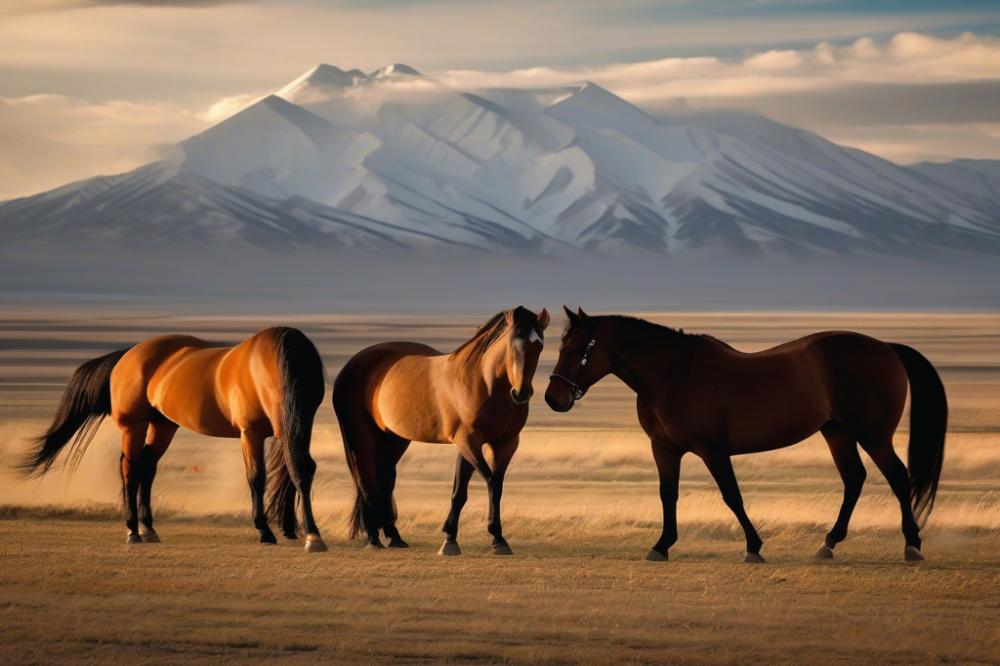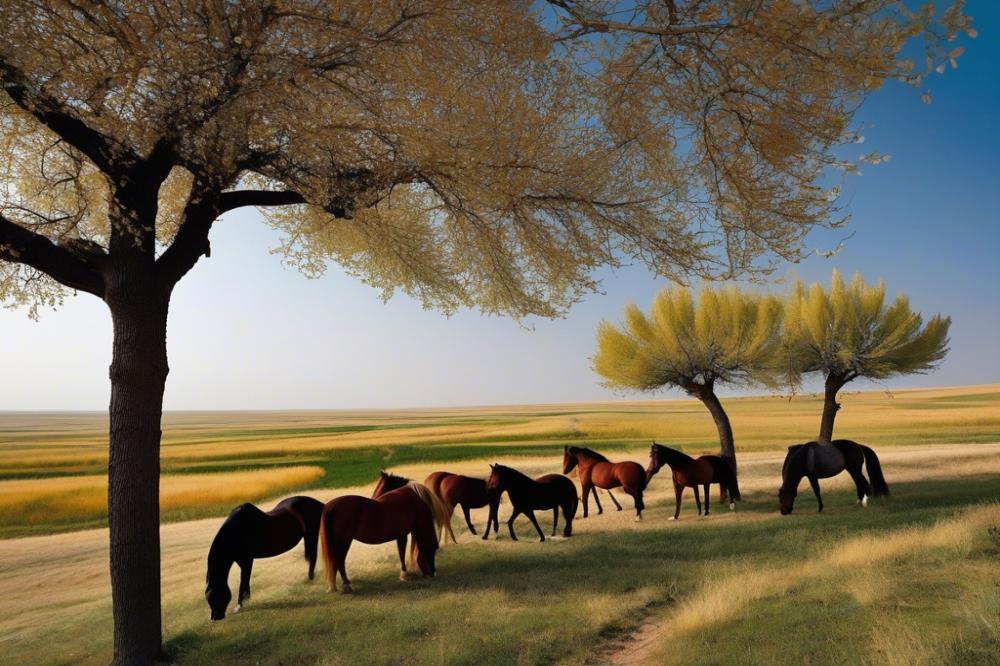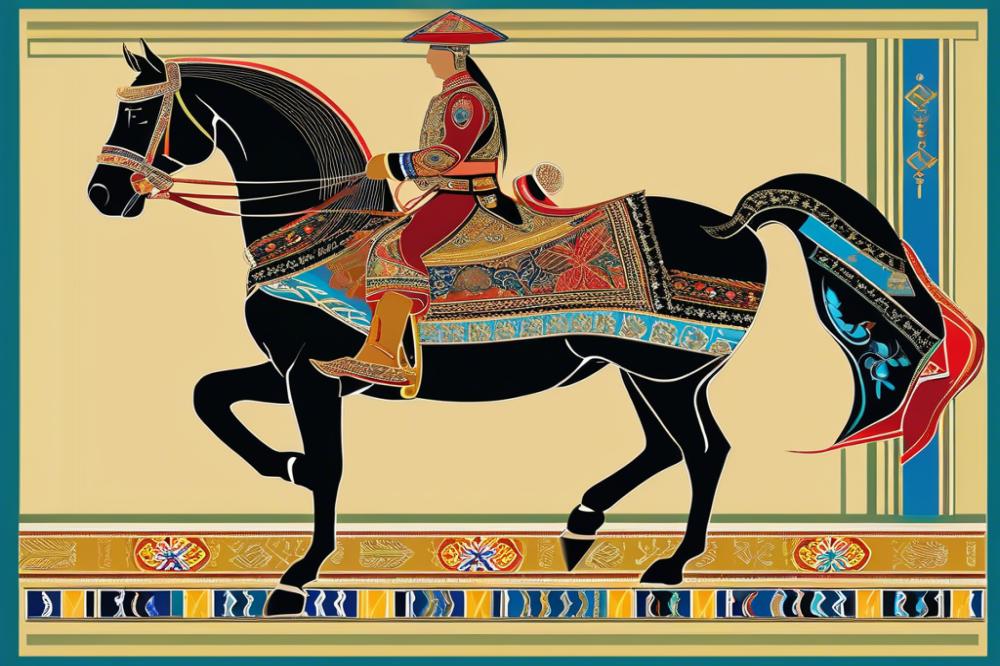Introduction
Kazakhstan is home to a staggering population of approximately 2.4 million horses. This significant number reveals much about the nation’s heritage. Horses have been a pivotal part of the Kazakh people’s history and their way of life. For centuries, these animals have influenced many aspects, from transportation to food production.
The relationship between the people and their horses is deep and enduring. They shape traditions and cultural practices. The nomadic lifestyle, which defines many communities, relies heavily on these majestic creatures. Horseback riding is more than just a means of transport; it symbolizes freedom and connection to the vast steppe.
This article aims to explore the multifaceted role of horses in Kazakhstan. We will delve into their cultural significance and economic impact. By examining various facets, we hope to provide a comprehensive view of how these animals enrich the lives of the people. The bond between humans and Kazakhstan horses is a tale worth telling. Readers will gain insights into the traditions and practices that revolve around these remarkable animals.
Historical Context of Horses in Kazakhstan

Horses have played a vital role in Kazakhstan’s history. Evidence suggests that domestication began over 5,000 years ago in the vast steppes of Central Asia. These animals were not just companions; they became integral to the survival of ancient nomadic tribes. Mobility was essential for these groups, and horses allowed them to traverse long distances while following seasonal pastures.
Through hundreds of years, they shaped the way of life for many communities. Trade routes flourished, facilitated by the speed and endurance of these creatures. Furthermore, the horse was pivotal in warfare, providing strategic advantages during conflicts.
Cultural reflections are abundant in Kazakh folklore and mythology. Stories often depict horses as symbols of freedom and strength. Legends frequently tell of heroics in battle, where the bond between rider and horse becomes legendary. This connection elevates the horse to a status beyond mere livestock. They symbolize the spirit of the nomadic lifestyle.
During traditional celebrations, equestrian sports highlight the importance of these animals. Competitions like kokpar and akhal-teke races showcase horsemanship skills and emphasize camaraderie. These events are not merely games; they reflect centuries of tradition and pride in horsemanship.
Moreover, the significance of horses extends into everyday life. They are essential for transporting goods and people, ensuring a stable livelihood for many families. In contrast to modern conveniences, the reliance on these animals fosters a strong connection to ancestral practices.
Kazakh mythology captivates the imagination, often featuring stories where horses exhibit supernatural qualities. Their speed and grace inspire numerous poems and songs, further embedding them in the cultural fabric. All around, horses are more than animals; they represent a way of life that is both practical and deeply revered.
Horses in Kazakh livelihood

Horses play a crucial role in the pastoral lifestyle of Kazakhstan. For many families, these animals are more than just livestock; they are a key part of daily life. Pastoralism relies heavily on horses for survival. These majestic creatures help people navigate the vast steppes and rugged mountains. Herding sheep and goats is often done on horseback, making it easier to manage large herds.
Breeding horses is critical for sustaining livelihoods in rural areas. Each horse carries the promise of income and mobility. Families may raise horses to sell, which provides essential funds for other needs. In this way, horses become a financial lifeline for many. The breeding process itself can be a labor of love, as owners develop strong bonds with their animals.
Transportation is another area where horses shine. Roads can be limited in remote regions, making horses an ideal choice for travel. Many people rely on them to transport goods to markets. This is especially true in areas where trucks cannot reach. Horses provide a reliable means of moving everything from food to firewood.
Trade related to horses also supports the local economy. Events like horse fairs and races attract attention and foster community ties. Sellers and buyers gather, showcasing their finest animals. This exchange is about more than just commerce; it’s a celebration of culture and shared heritage. In such instances, horses are a bridge connecting people with their history and traditions.
Traditional practices involving horses are not just economic, they also strengthen social bonds. Family gatherings often revolve around horse-related activities. Events such as horseback riding and training are communal experiences. Children learn skills from an early age and are often seen riding alongside their parents. These connections create lasting memories, emphasizing how intertwined horses are with Kazakh culture.
Nomadic Culture and Equestrian Traditions
The nomadic culture of the Kazakh people is deeply intertwined with the use of horses. For centuries, these animals have played a pivotal role in everyday life. Horses served as a primary mode of transport, enabling families to move with their herds across vast steppes. This lifestyle shaped not just how they live, but also how they view the world around them.
Traditional equestrian practices are rich and varied. Horseback riding is more than a skill; it is a way of life that resonates through generations. Herding techniques require not only expertise but also a strong bond between horse and rider. Kazakh herders often rely on their steeds to manage livestock effectively across sprawling landscapes.
Annual horse festivals bring communities together to celebrate these magnificent animals. Events like the Kokpar, a traditional game similar to polo, showcase the importance of equestrian skills. Festivals are filled with excitement, showcasing races and demonstrations of horsemanship. These celebrations are not just about competition; they honor the traditions that have thrived for many years.
Within Kazakh society, the horse holds significant social value. Owning horses often signifies wealth and high social standing. During community gatherings, a person’s identity can be closely associated with their equestrian background. Skills in riding and horsemanship are respected and admired, influencing how individuals are perceived within society.
A bond exists between horses and the nomadic lifestyle. Gaining proficiency in riding is viewed as essential. Young Kazakhs learn the ropes early, mastering the art of galloping across the plains. This practice not only boosts their confidence but also connects them to their heritage.
Horses also serve as a symbol of freedom and strength. For the Kazakh people, riding represents an escape, a return to their roots. It is a way to celebrate their connection to the land and its history. The horse is not merely an animal; it is a partner in the journey of life.
Cultural Heritage and Horse-Based Sports
The presence of horses in Kazakhstan plays a significant role in shaping the country’s cultural heritage. Throughout history, these animals have connected people, symbolizing strength and freedom. In towns and villages, horses are not just livestock; they are woven into the fabric of daily life. Traditions surrounding equestrian practices link the past with the present, showcasing the importance of these creatures.
Among the most cherished horse-related activities are traditional sports that reflect the values and skills of the Kazakh people. Kyz kuu, a thrilling game, involves a young man attempting to catch a girl riding away on horseback. This activity is not just playful; it signifies courtship and bravery. Riders display exceptional agility and speed, captivating the audience with their talents. Many families pass this tradition down through generations, fostering a sense of pride and community.
Another notable sport is Tyiyn teru, which translates to “picking up a coin”. In this thrilling competition, riders gallop at full speed to grab a small coin from the ground. This practice highlights not only the skill of the riders but also their connection with the land. It becomes a festive event where families and friends gather, cheering for their favorite competitors. The excitement brings people together, blending skill with community bonding.
Participating in these sports allows for cultural expression. They embody the spirit of the Kazakh people, emphasizing grace, courage, and intelligence. This deep-rooted connection to equestrian traditions can be witnessed during festivals. Events featuring these activities become a stage for showcasing local culture and talent. Engaging in horse-based sports nurtures a sense of belonging, uniting generations through shared experiences.
In Kazakh society, the bond between horses and people is more than mere companionship. It reflects the long-standing relationship of mutual respect and reliance. Through these traditions, horses become symbols of identity, resilience, and joy. People celebrate not just the sport but a rich heritage that continues to thrive amidst modernization. Such expressions of culture ensure the legacy of their ancestors lives on.
The Influence of Horses on Kazakh Cuisine
The bond between horses and traditional Kazakh cuisine runs deep. Horse meat, known as kazy, is often seen as a delicacy. This special food has a strong place in festivities and everyday meals alike. For many, it symbolizes strength and vitality.
In rural areas, horse meat can be a primary source of protein. Households often prepare rich dishes featuring it, revealing the importance of this animal in their daily lives. Besides meat, fermented horse milk called kumys holds a special significance. This drink is cherished for its unique taste and health benefits.
Many families proudly maintain the tradition of making kumys at home. The process involves fermenting fresh mare’s milk until it has a slightly sour flavor. Consuming this drink is not only refreshing but also connects people to their heritage.
Several methods exist for cooking horse meat. Some prefer it grilled, while others might choose to prepare it in stews or sausage. Each style highlights the versatility of this ingredient. Celebrations often feature large feasts where horse dishes take center stage, showing respect for this noble animal.
The cultural rituals surrounding horses extend to meals shared with family and friends. Gathering around a table laden with horse-based dishes strengthens community ties. Food is a way to bond and share stories, creating lasting memories.
In Kazakhstan, the culinary landscape reflects the vast history of the nomadic lifestyle. Recipes passed down through generations are valued treasures. They celebrate the horse’s crucial role, enriching both cuisine and culture.
Tourism and Equestrian Experiences
Kazakhstan attracts many tourists with its rich equestrian heritage. Traveling through the vast steppes on horseback offers visitors a glimpse into the nomadic lifestyle. Horses play a significant role in traditional culture. People can participate in horseback riding tours, which allow for an immersive experience. Such adventures often lead travelers to unforgettable landscapes and friendly locals.
Cultural exchanges arise when tourists connect with local guides. These guides share stories about their history and their relationships with horses. Visitors can learn to ride in traditional ways. Skills developed on these excursions often last a lifetime.
Interest in equestrian tourism is steadily increasing. Tourists search for authentic experiences away from typical attractions. Visiting stables and participating in local events helps preserve traditions. Horse-related festivals draw crowds and celebrate age-old customs. Local communities benefit from this growing interest.
Overall, equestrian tourism supports small businesses in rural areas. Local artisans can showcase their crafts and foods, directly benefiting from tourism. Visitors leave with memories, while local folks gain income. Opportunities are abundant for connections and understanding. Everyone shares in the joy that horses bring to Kazakhstan.
Traditional Crafts and Horses
The connection between horses and traditional crafts in Kazakhstan runs deep. For centuries, horses have been central to the way of life in this vast land. They are not just animals; they embody the spirit of the Kazakh people. This relationship has influenced many artisanal crafts that hold cultural significance.
Artisans often create unique horse gear, such as saddles and bridles. These items showcase the skills passed down through generations. Leatherwork is particularly important. Craftspeople skillfully mold and stitch leather, resulting in beautiful pieces that are both functional and artistic.
Various materials from horses also play a role in local crafts. Felt made from horsehair is a common element in traditional yurts, providing warmth during harsh winters. Additionally, decorative items like harnesses often feature intricate designs, symbolizing the bond between horse and rider.
The symbolism of horses is prominent in many crafts. Folk art frequently incorporates motifs inspired by these animals. From carvings to embroidery, the imagery captures the majesty of horses and their importance in Kazakh culture.
Moreover, competitions showcase these crafts at festivals. Craftsmen and women display their works, and communities celebrate their heritage. The skills involved in crafting horse equipment are highlighted, reminding everyone of the ongoing relationship between people and horses.
Through these crafts, traditional knowledge is preserved. Young apprentices often learn from masters, ensuring that these skills do not fade away. This passing down of knowledge is essential for maintaining cultural identity.
In summary, horses not only impact daily life but also inspire artisans to create beautiful works. The crafts associated with them reflect a rich cultural tapestry. These pieces tell stories of history, tradition, and respect for the horse, illustrating their esteemed place in Kazakh heritage.
Final Thoughts
Understanding the significance of horses in Kazakhstan reveals much about the nation’s heritage. These animals are not merely livestock; they carry deep cultural meaning. They have been part of the nomadic culture for centuries, serving as crucial companions and tools for survival. Their role extends beyond transportation and work; they are woven into the fabric of Kazakh identity.
Notably, the relationship between people and horses shapes livelihoods across the country. Communities thrive on traditions and practices passed down through generations. Equine-based events, like the famous kokpar, symbolize communal spirit and resilience. They highlight the shared values that define Kazakhstan’s culture.
Furthermore, the bond with these creatures influences art, music, and storytelling. Horses inspire creativity in various forms, acting as symbols of freedom and strength. The representation of horses in local folklore underscores their lasting impact on collective memory.
Looking toward the future, it is essential to appreciate and preserve this vital aspect of Kazakh heritage. As modernization continues, understanding the historical role of horses can guide efforts to maintain cultural integrity. By valuing their connection with these animals, communities can honor their past while nurturing their identity for generations to come.



